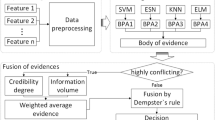Abstract
In this study, we introduce an ensemble system by combining homogeneous ensemble and heterogeneous ensemble into a single framework. Based on the observation that the projected data is significantly different from the original data as well as each other after using random projections, we construct the homogeneous module by applying random projections on the training data to obtain the new training sets. In the heterogeneous module, several learning algorithms will train on the new training sets to generate the base classifiers. We propose four combining algorithms based on Sum Rule and Majority Vote Rule for the proposed ensemble. Experiments on some popular datasets confirm that the proposed ensemble method is better than several well-known benchmark algorithms proposed framework has great flexibility when applied to real-world applications. The proposed framework has great flexibility when applied to real-world applications by using any techniques that make rich training data for the homogeneous module, as well as using any set of learning algorithms for the heterogeneous module.
Access this chapter
Tax calculation will be finalised at checkout
Purchases are for personal use only
Similar content being viewed by others
References
Nguyen, T.T., Liew, A.W.C., Tran, M.T., Pham, X.C., Nguyen, M.P.: A novel genetic algorithm approach for simultaneous feature and classifier selection in multi classifier system. In: IEEE CEC, pp. 1698–1705 (2014)
Nguyen, T.T., Dang, M.T., Liew, A.W.C., Bezdek, J.C.: A weighted multiple classifier framework based on random projection. Inf. Sci. 490, 36–58 (2019)
Kittler, J., Hatef, M., Duin, R.P.W., Matas, J.: On combining classifiers. IEEE Trans. Pattern Anal. Mach. Intell. 20(3), 226–239 (1998)
Zhang, Y., Cao, G., Wang, B., Li, X.: A novel ensemble method for k-nearest neighbor. Pattern Recogn. 85, 13–25 (2019)
Nguyen, T.T., et al.: Deep heterogeneous ensemble. Aust. J. Intell. Inf. Process. Syst. 16(1), 1–9 (2019)
Nguyen, T.T., Nguyen, M.P., Pham, X.C., Liew, A.W.C., Pedrycz, W.: Combining heterogeneous classifiers via granular prototypes. Appl. Soft Comput. 73, 795–815 (2018)
Kuncheva, L.I., Bezdek, J.C., Duin, R.P.W.: Decision templates for multiple classifier fusion: an experimental comparison. Pattern Recogn. 34, 299–314 (2001)
Nguyen, T.T., Nguyen, T.T.T., Pham, X.C., Liew, A.W.C.: A novel combining classifier method based on variational inference. Pattern Recogn. 49, 198–212 (2016)
Zhang, C.X., Zhang, J.S.: RotBoost: a technique for combining rotation forest and AdaBoost. Pattern Recogn. Lett. 29(10), 1524–1536 (2008)
Warmuth, M.K., Liao, J., Ratsch, G.: Totally corrective boosting algorithms that maximize the margin. In: Proceeding of ICML, pp. 1001–1008 (2006)
Dang, M.T., et al.: An ensemble system with random projection and dynamic ensemble selection. In: Proceeding of ACIIDS, pp. 576–586 (2018)
Johnson, W., Lindenstrauss, J.: Extensions of Lipschitz mapping into Hilbert space. In: Conference in Modern Analysis and Probability of Contemporary Mathematics, American Mathematical Society, vol. 26, pp. 189–206 (1984)
Pham, X.C., et al.: Learning from data stream based on random projection and Hoeffding tree classifier. In: Proceeding of DICTA (2017)
Author information
Authors and Affiliations
Corresponding author
Editor information
Editors and Affiliations
Rights and permissions
Copyright information
© 2020 Springer Nature Switzerland AG
About this paper
Cite this paper
Luong, A.V. et al. (2020). A Homogeneous-Heterogeneous Ensemble of Classifiers. In: Yang, H., Pasupa, K., Leung, A.CS., Kwok, J.T., Chan, J.H., King, I. (eds) Neural Information Processing. ICONIP 2020. Communications in Computer and Information Science, vol 1333. Springer, Cham. https://doi.org/10.1007/978-3-030-63823-8_30
Download citation
DOI: https://doi.org/10.1007/978-3-030-63823-8_30
Published:
Publisher Name: Springer, Cham
Print ISBN: 978-3-030-63822-1
Online ISBN: 978-3-030-63823-8
eBook Packages: Computer ScienceComputer Science (R0)




